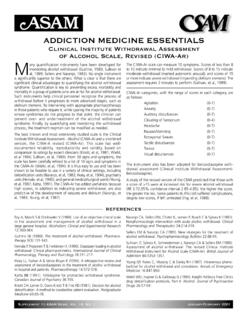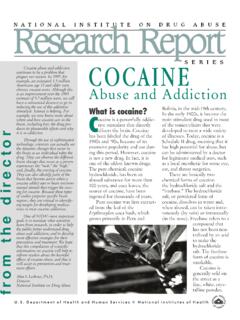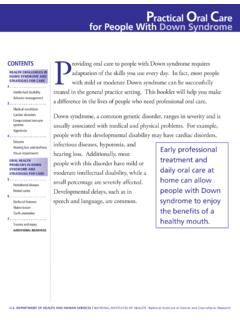Transcription of Inpatient Alcohol Withdrawal Guidelines - Veterans Affairs
1 5/17/00 Inpatient Alcohol Withdrawal Guidelines PURPOSE: To provide Guidelines for safe and consistent management of uncomplicated Alcohol Withdrawal , which is usually completed in 48-96 hours. Patients are at risk for Withdrawal when abruptly reducing or stopping Alcohol : Risk factors: History of previous severe Withdrawal , Withdrawal seizures, or DTs; increased duration and amount of drinking; binge pattern; multiple past detox; and concurrent medical illness may increase the risk for complicated or more severe Withdrawal . ASK: What is your drinking pattern like now and has it changed?
2 Do you drink every day, how much, and do you need a daily "eye opener"? Have you ever experienced blackouts (cannot remember periods of time when drinking)? What ( Withdrawal sx) do you experience when you stop drinking? When was your last drink? Have you ever had DTs, seizures, or hallucinations? Have you ever undergone detox treatment before and how many times? Medical problems such as liver disease, pancreatitis, or intestinal bleeding? Are you taking medication or using drugs other than Alcohol ? SIGNS and SYMPTOMS: Within a few to 48hrs Tremor Nausea/vomiting Diaphoresis Anxiety of cessation or reduction Elevated BP, HR Abdominal cramps Headache Perceptual disturbance or misperceptions Within 72 hrs Generalized tonic-clonic seizures (most by 48hr, usually single, some multiple) 48hrs 7 days Delirium tremens.
3 Autonomic hyperarousal, disorientation, hallucinations, tremors Medical emergency requiring intensive treatment and beyond these Guidelines . VITAL SIGNS: Common to see increased BP, HR, RR, temp. Some patients can have severe Withdrawal including DTs and seizures without markedly elevated vital signs. Can also have elevated vital signs for concurrent illnesses other than Alcohol Withdrawal ( acute pain, infection, dehydration, etc.). Recommend VS Q4 hrs (while awake) and 1 hour after benzodiazepine dose. If VS remain elevated consider additional or increased dose of benzodiazepine, adding PRN clonidine, or possibility of other etiology for abnormal vital signs.
4 LABS: BAC (or BAL) at admission. High level suggests tolerance and increased Withdrawal risk. Withdrawal can develop before BAC reaches < 100mg%. BAC > 400 mg% requires medical monitoring for Alcohol poisoning. Drug screen, UA, chem7, Mg++, GGT, SGOT, SGPT, alk phos, t. bili, CBC, PPD. Consider hep C & B panel, PT, : "Symptom triggered" (PRN) recommended over scheduled taper for uncomplicated Withdrawal . For Withdrawal symptoms: Benzodiazepine (see protocol on reverse side) Chlordiazepoxide and diazepam have longer half-lives, smoother self-taper. Lorazepam better for elderly or liver impairment, most reliable benzo for IM absorption.
5 Risk of late onset Withdrawal seizures upon abrupt cessation of shorter acting agents (oxazepam). For history of Withdrawal seizures: Give scheduled benzodiazepine dose Q6hr x 4 (50mg chlordiazepoxide equivalents per dose) as prophylactic seizure precaution. Give additional benzo PRN Withdrawal sx. Additional meds: Thiamine 100mg daily (give IV before IV glucose to prevent Wernike's encephalopathy). Multivitamin and folate. Antacid PRN. Magnesium replacement if markedly low or symptomatic. CONSULTATION: For further assessment of treatment needs or patient wants treatment, consult ATC Some services may choose to use additional criteria such as objective Withdrawal scales (CIWA-Ar) for assessing and managing Alcohol Withdrawal and/or fit these Guidelines to their particular patient population.
6 References: Mayo-Smith, Meta-analysis and Evidenced-Based Guideline, JAMA, July 9 1997,vol 278, no 2, pp , Recognition and Management of Occult Alcohol Withdrawal , Hospital Practice, June 15 1995, pp 49-58. Foy, Use of Objective Clin. Scale in Assess/Management of EtOH w/d in Gen Hosp; Exp Res, 14:1:1990, p360. Saitz, Individualized treatment for Alcohol Withdrawal , JAMA, Aug 17, 1994, vol 272, no 7, pp 519-523. 7/28/99 Alcohol Withdrawal Standing Orders for Medicine and Surgery 1. Record blood Alcohol concentration (BAC) by Breathalyzer or blood sample.
7 Record patient's BAC and reported time and date of last Alcohol use on CIWA-Ar flowsheet. 2. If BAC > and patient has symptoms of Withdrawal , call medical provider before administering medication for Alcohol Withdrawal . When BAC < , measure CIWA-Ar score. 3. If BAC > and no signs of Withdrawal , check BAC periodically (estimate rate of decline at ) until BAC < 4. For diabetic patient, check blood glucose by fingerstick. Notify medical provider if blood glucose <80 or >300 5. ___ (Dr. initial) Patient has history of Withdrawal seizures. Give seizure prophylaxis : Chlordiazepoxide 50 mg q6h x 4, begin when BAC < (or sooner if directed by medical provider).
8 6. If CIWA-Ar score < 10, repeat CIWA-Ar q shift. Repeat sooner if symptoms worsen. 7. If CIWA-Ar score is 10 or greater, give oxazepam 30mg po OR chlordiazepoxide 50mg po as ordered, and repeat CIWA-Ar in 1 hour (awaken if asleep). Consult medical provider for additional medication orders as needed. 8. Continue with 6 and 7 above as indicated by the subsequent CIWA-Ar scores. Discontinue CIWA-Ar monitoring when subsequent. CIWA-Ar<5 for two consecutive shifts. 9. Continue medication as ordered and alert medical provider when patient requires more than 210mg of oxazepam or 350mg of chlordiazepoxide in 24 hours.
9 Patient may continue medication per protocol if needed. 10 Notify HO if CIWA >19, significant fall risk, requires restraints, risk of harm to self or others, OR acute mental status changes such as confusion or delirium. 11. Do not administer oxazepam/chlordiazepoxide if signs of benzodiazepine toxicity (ataxia, heavy sedation, slurred speech, mood lability). 12. Fall Precautions. 13. Encourage fluids. 14. Restrict to ward for first 24 hours or as long as patient requires close monitoring.





